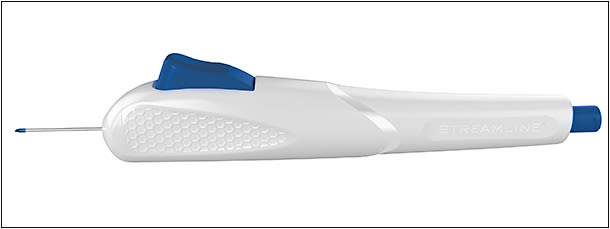While he was looking for a safe and effective procedure to help patients either lower their intraocular pressure (IOP) or minimize their need for eye drops to treat their disease, Leonard K. Seibold, MD, a professor in the department of ophthalmology at the University of Colorado School of Medicine in Aurora, decided to try New World Medical’s STREAMLINE Surgical System.
“In particular, I wanted to have a tool that allowed a more tailored approach across a wide range of mild to moderate disease,” says Dr. Seibold, who was involved in the early soft launch of the device in the United States and now uses it regularly. “I also wanted a versatile solution that could be easily paired with cataract surgery, but not leave an implant behind. The STREAMLINE device fit that bill.” The system’s intuitive design was also a big draw for Dr. Seibold, along with its ability to address multiple sites of outflow resistance all with the simple press of a button.

How It Works
The STREAMLINE system is a first-line, implant-free solution that is specifically designed to create precise incisions and titratable goniotomies through the trabecular meshwork and has the capability to deliver ophthalmic viscoelastic into the eye during cataract surgery or as a standalone procedure, says Raymond Kong, chief commercial officer at New World Medical in Rancho Cucomonga, California.
According to Dr. Seibold, the system works by addressing outflow resistance along the traditional outflow pathway at the level of the trabecular meshwork, Schlemm's canal, and distal collector channels. The device’s outer sleeve can be safely applanated against the trabecular meshwork, and when the button is depressed, the sleeve retracts and draws the trabecular meshwork toward the sleeve. This allows the inner cannula to create a precise incision and deliver viscoelastic into Schlemm's canal and collector channels.
This process can be repeated across several clock hours of the angle with 3 to 8 applications. The initial incisions can be titrated further by using the cannula to extend the trabecular meshwork incisions and extend an incisional goniotomy under a surgeon’s control.
“This has resulted in a significant decrease in IOP postoperatively, along with a reduced need for glaucoma medications,” Dr. Seibold says.
Advanced Technology
The new and innovative Clickpulse technology allows the device to create multiple precise incisions through the trabecular meshwork and deliver a specific amount of ophthalmic viscoelastic fluid into Schlemm's canal in 1 unified step, Kong says. These incisions can be further extended to create titratable goniotomies across several clock hours of the trabecular meshwork independent of viscoelastic delivery.
“No other device on the market can accomplish this task so efficiently and with such minimal disruption to tissue,” Dr. Seibold says. “Furthermore, the ability to titrate the treatment based on individual patient needs sets it apart from other devices.”
In a study1 of 20 patients with glaucoma who underwent goniotomy and viscodilation with the STREAMLINE surgical system, 89.5% experienced at least a 20% reduction in IOP and no increase in medication use. The average IOP decreased from 23.5 mmHg to 14.7 mmHg after 6 months, and the average number of medications decreased from 2.0 at screening to 1.1.
Avoiding Implants
Although implants can be effective in bypassing outflow resistance, several issues can limit their effectiveness. First, their efficacy is dependent on accurate placement, and studies2,3 have shown that often, positioning is imperfect, even with experienced surgeons, Dr. Seibold says.
Secondly, an implant can incite fibrosis leading to device occlusion with time. Finally, there is concern that leaving an implant behind may cause dysfunction or loss of the corneal endothelial cells, resulting in problems later, Dr. Seibold says. These issues can be avoided when using STREAMLINE because no implant is left behind.
User Experience
Several features ensure a user-friendly experience. First, a blue outer sleeve provides enhanced visibility in the eye to ensure accurate positioning of the device, Dr. Seibold says.
Furthermore, the hand piece is ergonomically designed to fit in a surgeon’s hand comfortably and allow for easy depression of the button to deliver treatment. Additionally, the option to deliver multiple treatments and extend goniotomies gives surgeons the ability to titrate treatment for an individual eye, he says.
Clinical Applications
The system can be used across a broad spectrum of open-angle glaucoma patients. However, Dr. Seibold says the best patients for this device are those with mild to moderate glaucoma who have open angles and readily identified angle structures.
For patients who use 1 to 3 medications with controlled pressures, but who are also planning to have cataract surgery, STREAMLINE can be an excellent option to help decrease their need for eye drops after surgery, he continues. STREAMLINE can also be used for patients with IOP above their goal who need further reduction.
“The device can be especially advantageous for patients whose pressure may be controlled with eye drops but who are plagued with the myriad side effects and ocular surface disease that often come along with topical glaucoma therapy,” Dr. Seibold says. Compared to implant-based microinvasive glaucoma surgery, STREAMLINE can be employed as a standalone procedure for pseudophakic patients or those who don’t need cataract surgery. Also, because the procedure involves minimal tissue disruption, patient recovery is often similar to cataract surgery alone. GP
Reference
- Lazcano-Gomez G, Garg SJ, Yeu E, Kahook MY. Interim analysis of STREAMLINE surgical system clinical outcomes in eyes with glaucoma. Clin Ophthalmol. 2022;16:1313-1320. doi:10.2147/OPTH.S358871
- Dorairaj S, Balasubramani GK. Corneal endothelial cell changes after phacoemulsification combined with excisional goniotomy with the Kahook Dual Blade or iStent: a prospective fellow-eye comparison. Clin Ophthalmol. 2020;14:4047-4053. Published 2020 Nov 24. doi:10.2147/OPTH.S263072
- Gillmann K, Bravetti GE, Mermoud A, Mansouri K. A prospective analysis of iStent inject microstent positioning: Schlemm canal dilatation and intraocular pressure correlations. J Glaucoma. 2019;28(7):613-621. doi:10.1097/IJG.0000000000001273








